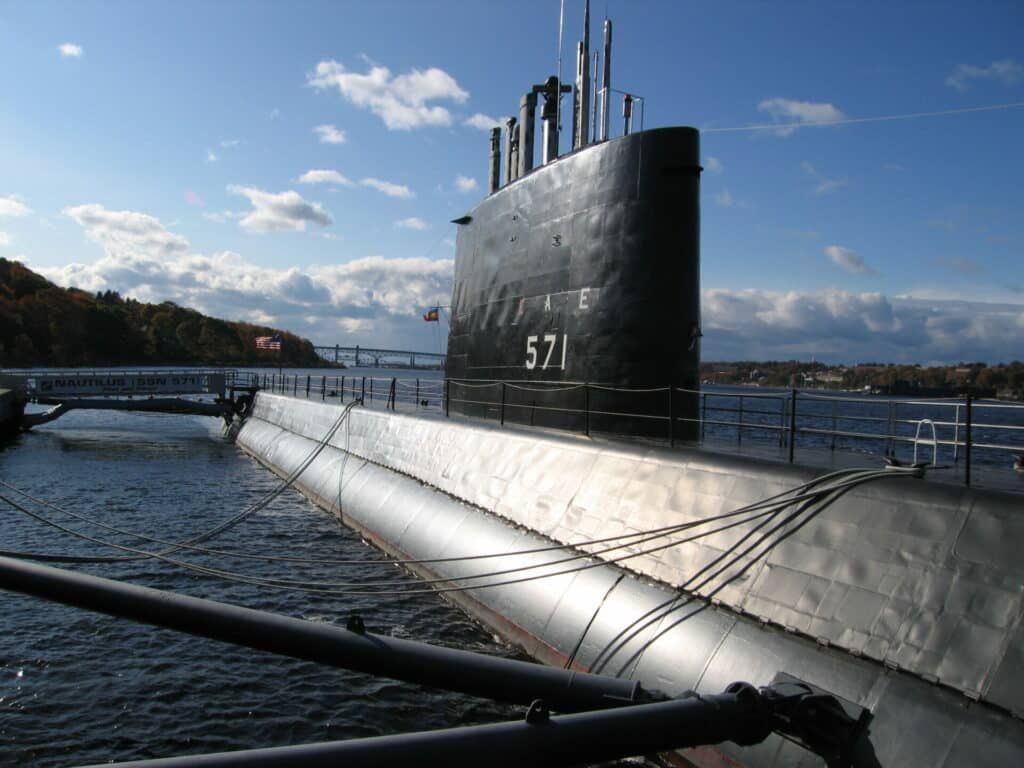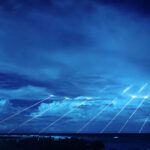AUKUS and nuclear-powered submarines: Let’s all just take a breath
By Noah C. Mayhew | November 17, 2022
 The USS Nautilus (SSN-571), launched in 1954, was the world's first nuclear-powered submarine. It is now permanently docked at the US Submarine Force Museum and Library, Groton, Connecticut. Credit: Victor-ny. Accessed via Wikimedia Commons. CC BY-SA 3.0
The USS Nautilus (SSN-571), launched in 1954, was the world's first nuclear-powered submarine. It is now permanently docked at the US Submarine Force Museum and Library, Groton, Connecticut. Credit: Victor-ny. Accessed via Wikimedia Commons. CC BY-SA 3.0
Since the September 2021 announcement of the Australia-United Kingdom-United States (AUKUS) partnership entailing a “trilateral effort of 18 months to seek an optimal pathway” to help Australia acquire nuclear-powered submarines, experts opposed to such acquisition have made grave predictions about it. When I first heard the announcement, I was unconcerned. While nuclear-powered submarines in a non-nuclear weapon state’s possession would be unprecedented, safeguards—technical measures implemented by the International Atomic Energy Agency (IAEA)—are designed to ensure that sensitive nuclear technology is not diverted toward the manufacture of nuclear weapons. As these measures are in place for Australia, I saw no need for concern. What has raised concern is the alarm over AUKUS from a small but vocal minority of countries, clearly driven by geopolitics rather than safeguards.
This issue played out in dramatic fashion in September at the IAEA’s annual General Conference in Vienna. On the one hand, in his opening remarks Director General Rafael Mariano Grossi said unequivocally that the drafters of the document on which the vast majority of safeguards agreements are based (an information circular known as INFCIRC/153) recognized that military naval nuclear propulsion was a permitted activity. On the other hand, whether to address AUKUS in a conference resolution (and if so, how) was the subject of intense debate during conference deliberations.
The Chinese delegation attempted not only to push a separate resolution on AUKUS and its implications for IAEA safeguards, but also to insist on AUKUS-related language in other conference resolutions—including resolutions on the IAEA’s safeguards system, the application of safeguards in North Korea, and even the IAEA’s budget. Ultimately, China dropped its resolution when it failed to win support beyond a few other IAEA member states.
Nuclear-powered submarines are no small thing. They involve militarily sensitive nuclear technology that to date only the five nuclear weapon states recognized by the Nuclear Non-Proliferation Treaty (NPT) command. Insistence that the AUKUS effort should set a strong precedent and be conducted in close consultation with the IAEA is well founded. However, the way in which some countries have responded to the initiative in the IAEA’s Board of Governors has been unconstructive.
The legal framework and nuclear-powered submarines. The NPT—the international community’s foundational nuclear treaty—prohibits non-nuclear weapon states from receiving nuclear weapons, other nuclear explosive devices, or control over nuclear weapons; manufacturing or otherwise acquiring nuclear weapons; or receiving any assistance in doing so. The treaty also prohibits nuclear weapon states from facilitating nuclear weapons acquisition by others. However, it makes no mention of non-explosive military uses such as naval nuclear propulsion.
The treaty does require countries that are party to it (with the exception of the five nuclear weapon states) to conclude an agreement with the IAEA for the application of safeguards “on all [nuclear] material in all peaceful nuclear activities.” These so-called comprehensive safeguards agreements, based on INFCIRC/153, contain a provision that a member state can invoke for the “non-application” of safeguards to nuclear material used in activities that are not prohibited under the agreement. This provision is spelled out in paragraph 14 of INFCIRC/153 and is understood to apply to naval nuclear propulsion.
Any country invoking paragraph 14 must make an arrangement with the IAEA so that the non-application of safeguards will happen only while the nuclear material is being used in the non-prohibited activity. To date, paragraph 14 has been invoked only once—by Canada, which was interested in nuclear-powered submarines but ultimately decided not to pursue them, so no arrangement with the IAEA was made.
Should Australia invoke paragraph 14, it would be a novel case in which many complex legal and technical questions would require answers (though some questions are explained by the IAEA safeguards system’s seminal documents, as shown in this brief). However, this problem is far from unsolvable. The allowance for naval nuclear propulsion exists, and it would be unrealistic to try to remove it from all countries’ safeguards agreements. Moreover, even if the AUKUS partnership does not result in the provision of nuclear-powered submarines, Australia will not be the last country to consider this.
In my view, the IAEA Director General would certainly not approve a paragraph 14 arrangement that does not satisfy the basic undertaking of the safeguards agreement, namely to verify that nuclear material is not diverted to nuclear weapons, other nuclear explosive devices, or for purposes unknown.
Fuel constraints. Should the AUKUS partnership proceed with transferring nuclear-powered submarines to Australia, they would be supplied by the United States or the United Kingdom, both of which use highly enriched uranium to fuel their own submarines. This means the reactors in the supplied submarines would likely also operate on fuel enriched to around 93 percent uranium 235.
While the transfer of highly enriched uranium has understandably caused consternation, Australia would not have direct access to that material. Currently the idea is that fuel for the Australian submarines would be supplied in the form of prefabricated, welded power units that would be installed in the submarine reactor. The reactor would then be sealed inside the hull of the submarine, and would not require any refueling during its approximately 30-year lifespan. Australia would have to rip open the sealed hull to get to the fuel, which would be readily apparent in satellite imagery and would require lengthy and complex repair.
In other words, while the supply of highly enriched uranium to a non-nuclear weapon state is certainly counter to efforts by the United States to minimize the amount of such uranium in the world, Australia would not be able to get to that material undetected. The alternative would be a submarine fueled by uranium of a lower enrichment, but that would require that the submarine be refueled from time to time (thereby allowing Australia access to the fuel) and that Australia find another submarine supplier. (None of the existing US or UK submarine designs could accommodate a reactor fueled by low-enriched uranium.)
Aside from the technicalities, it is useful to reflect on what the AUKUS partners have and haven’t decided. The partnership announcement described an effort to seek “an optimal pathway” for the provision of nuclear-powered submarines. No decision that the submarines will be supplied has been announced. So far, the submarine deal envisioned under the AUKUS partnership is essentially a feasibility study. Since the initial announcement, the AUKUS countries and the IAEA Secretariat have conducted eight technical meetings (seven prior to this report by the Director General and one since) related to naval nuclear propulsion, including on what a paragraph 14 arrangement could entail. The discussions during those meetings are not a matter of public record, but neither are any bilateral consultations between the IAEA and a member state.
Outstanding questions. Many questions about the AUKUS partnership remain unanswered. For a study that is just over a year old, this is not unexpected. The consultation period for the study is set to end in March 2023. At that point, these questions will need solid answers, developed in consultation between AUKUS countries and the IAEA, before any nuclear‑powered submarine deal is made:
How can the IAEA verify the fuel? As it stands now, the idea is that the United States or the United Kingdom would transfer prefabricated submarine components that would be assembled in Adelaide, Australia. The welded power units would be loaded and sealed before delivery and installation in the submarine reactors, which means that Australia cannot access the fuel, but it also means that the IAEA’s task of verifying that fuel becomes more complex. The form and composition of naval nuclear fuel is highly classified, and there are doubts as to whether the supplier countries would let the IAEA anywhere near the fuel to verify it. The United States and the United Kingdom are under no obligation to allow the IAEA to inspect their nuclear installations, but Australia is. While the United States or United Kingdom might restrict access by the IAEA as a condition of supplying the submarines, the bottom line is that some allowance will have to be made for the IAEA to verify the fuel before an arrangement for the non-application of safeguards can be approved. This could conceivably be done in a way that allows the IAEA to verify the fuel once control is transferred to Australia, but does not give the IAEA access to classified information. Ultimately, the IAEA will have to be satisfied with the arrangement for it to move forward.
How will the IAEA draw safeguards conclusions? Every year, the IAEA draws conclusions about safeguards implementation for countries that have safeguards agreements in force. If the IAEA finds no indication that declared nuclear material has been diverted, and no indication of any undeclared nuclear material or activities, the IAEA can draw what is referred to as the “broader conclusion” that all nuclear material remained in peaceful activities in that year. While a nuclear-powered submarine is certainly not equivalent to a nuclear weapon, it is hardly a peaceful use. Australia would either have to be comfortable with not receiving the so-called broader conclusion, or the IAEA would have to formulate a different conclusion for Australia. In either case, the IAEA could not conclude that “all nuclear material remained in peaceful uses.”
How is the paragraph 14 arrangement approved? It has been assumed that the IAEA’s Board of Governors will have to approve any arrangement regarding the non-application of safeguards for a nuclear-powered submarine program, but that is not written anywhere. The language regarding comprehensive safeguards agreements says the agency and the member state “shall make an arrangement,” with no mention of the board. The Secretariat’s note that served as a basis for drafting INFCIRC/153 did contain a requirement that such an arrangement be approved by the board—but the member states insisted on removing that requirement, on the grounds that no member state should be able to deny another the right to invoke paragraph 14 for a non-prohibited use.
Brazil’s nuclear-powered submarine program. With all the controversy over the AUKUS partnership, it is somewhat surprising that more attention is not being paid to Brazil’s decades-old naval nuclear propulsion program. Unlike Australia, Brazil has developed a separate nuclear fuel cycle dedicated to its nuclear-powered submarine program. Brazilian submarines would run on low-enriched uranium, rather than the more proliferation-sensitive highly enriched uranium.
After the announcement of the AUKUS partnership, Brazil took quick action to begin preliminary discussions with the IAEA on what its nuclear naval propulsion arrangement could look like. The fact that Australia’s ambitions for nuclear-powered submarines have caused such an uproar while Brazil’s similar ambitions have barely been acknowledged in the last year indicates to me that the opposition to nuclear-powered submarines is not related to safeguards, but rather to geopolitics.
Give it time. Nobody is doubting that there are important questions associated with naval nuclear propulsion in non-nuclear weapon states. However, manufacturing a submarine crisis at the IAEA will not bring faster answers to those questions. Governments are pressing for transparency, and rightly so, but the AUKUS partnership is barely a year old. If submarine acquisition moves forward, Australia should be prepared to answer questions from the IAEA’s Board of Governors in detail. But we simply aren’t there yet.
Some have alleged that the IAEA’s negotiating records of INFCIRC/153 are unavailable to the public (although the records are freely available upon a visit to the IAEA Archives Division) and accused the IAEA of playing fast and loose in interpreting its mandate. Notably, the Chinese delegation in a recent board meeting accused the AUKUS countries of working to reduce the IAEA to a “nuclear proliferation agency.” This accusation is, mildly speaking, hyperbolic and is detrimental to resolving the questions surrounding safeguards and naval nuclear propulsion.
The Chinese suggestion for an open-ended consultation to determine a formulaic approach to paragraph 14 arrangements could be considered, on the condition that the process be technical in nature rather than political. In the absence of this, countries that are concerned about naval nuclear propulsion would do well to direct their attention to coming up with creative technical solutions that don’t endanger classified information.
Like Rome, Australian nuclear-powered submarines won’t be built in a day—if ever. So don’t fixate on Rome burning.
Together, we make the world safer.
The Bulletin elevates expert voices above the noise. But as an independent nonprofit organization, our operations depend on the support of readers like you. Help us continue to deliver quality journalism that holds leaders accountable. Your support of our work at any level is important. In return, we promise our coverage will be understandable, influential, vigilant, solution-oriented, and fair-minded. Together we can make a difference.
Keywords: AUKUS, submarines
Topics: Nuclear Energy, Nuclear Risk, Nuclear Weapons, Opinion, Voices of Tomorrow
















Yes, from thev perspective of NPT, AUKUS isn’t a big deal.
But it does likely lead to weaponry that will challenge Chinese control of the South China Sea. It also creates a relationship that will grow. Ie, some are already calling for sharing the B-21 stealth bomber with Australia.
China is very aware of this, responding to AUKUS with a deepening of their military alliance with Russia. These moves towards new and stronger alliances undermine the ability for nations to collectively prevent and end war.
We in Australia have learnt that you cannot argue with rogue nuclear countries , ie North Korea, China , Russia soon to be Iran . North Korea , China and Russia have all threatened australia and have in China’s case canceled valuable trade items to try and control our free speech , we had subdued threats with their navy sailing close to our shores,we have aright to protect ourselves
Some of us in Australia, aren’t surprised at China’s position on the issue. Since the IAEA seems to have taken no effective action against China, as it has expanded its nuclear weapons’ programs, including not only acquiring nuclear powered, but nuclear armed submarines, why should China have any credibility in its diplomatic stance against Australia acquiring nuclear powered submarines? Unlike China, Australia has never invaded or taken control over other nations; I recall growing up and having read and heard about a Pacifist utopia nation named Tibet, which according to China, no longer exists. I’m sure the Dalai Lama remembers… Read more »
Noah is not in possession of clear facts, indeed , about enriched uranium, it was an AUSTRALIAN company named SILEX that RECENTLY developed a way to enrich uranimum to weapons grade 505 faster and gave that tech to the USA, Australia has abundant uranium and the tech to enrich it if it wants to. Noah is also being misleading in suggesting Australia is acquiring either USA or British subs, as they will be of new design and manufactured in Austrlia.